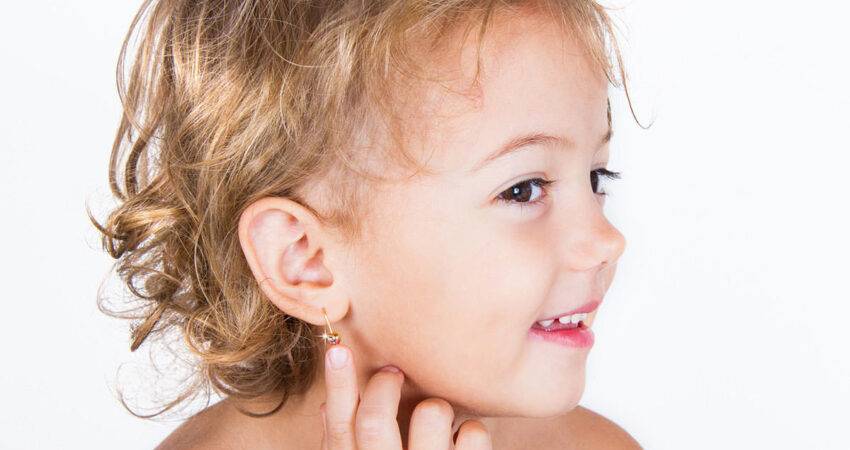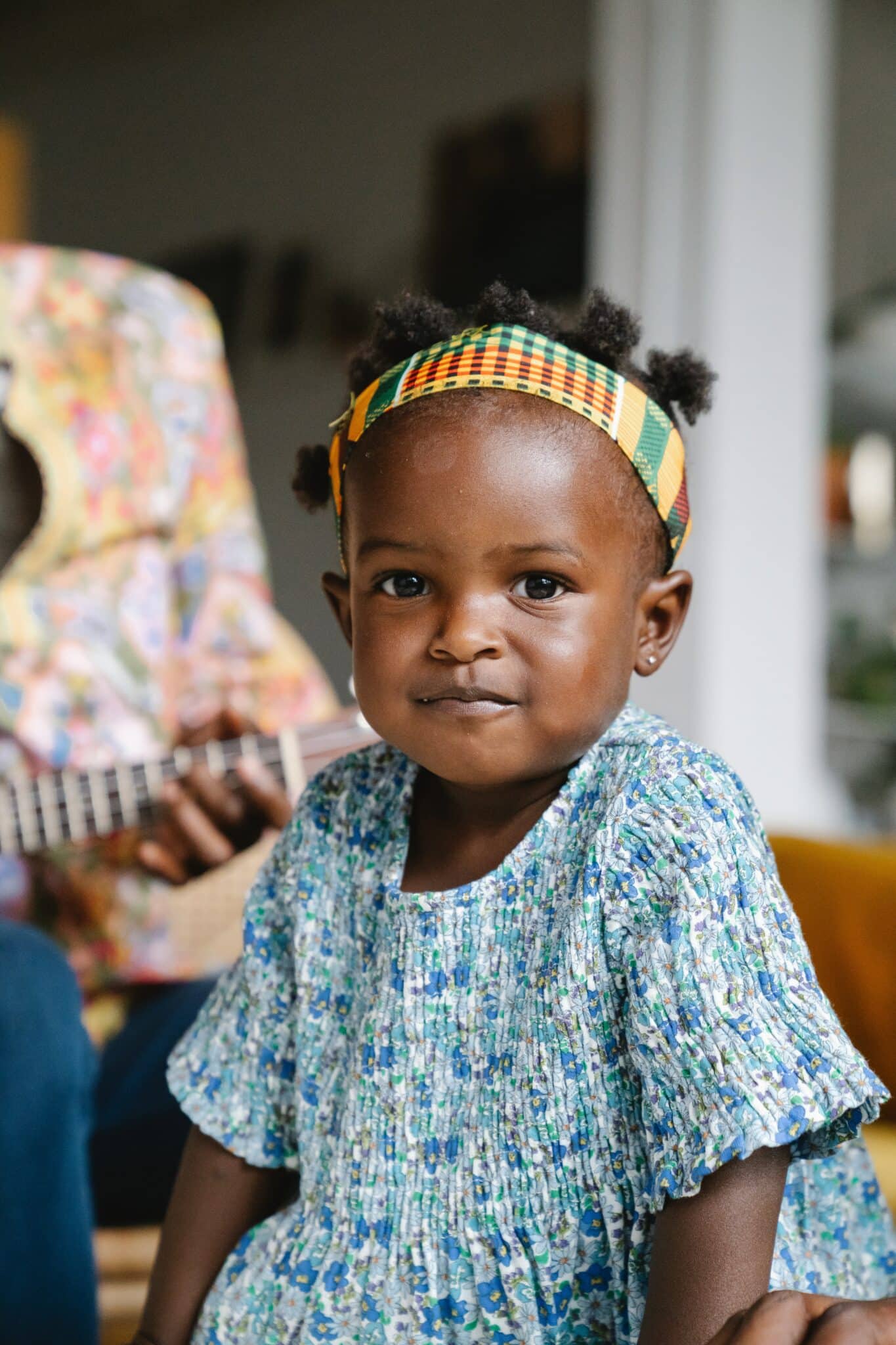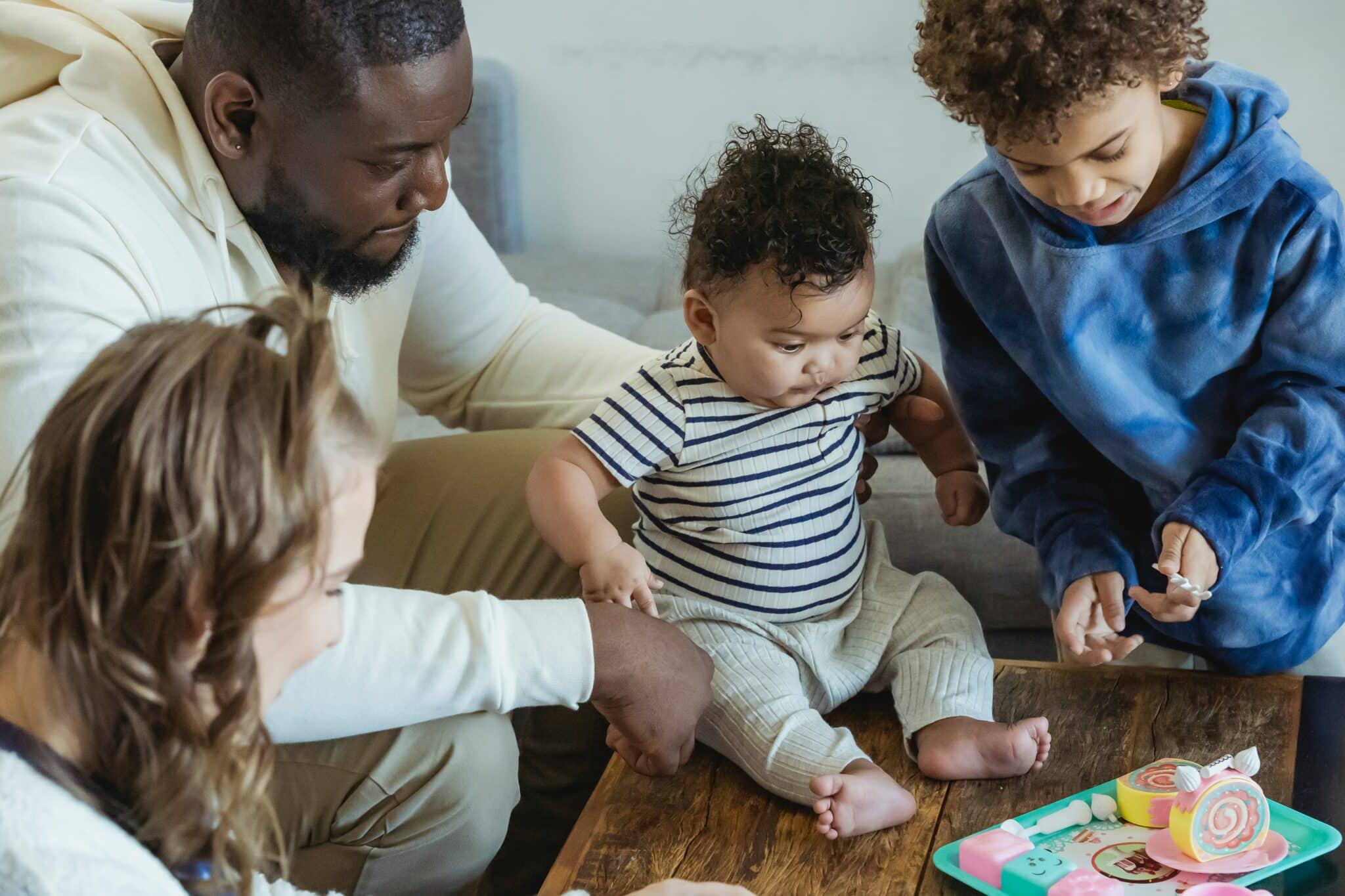Table of Contents
Are you thinking about having your child’s ears pierced? While this is an exciting time in any girl’s life, there are a few things to consider beforehand. You might be confronted with a few questions that bother you.
What is the best age for ear piercings? What is the best type of ear piercing? Where can I safely get my child’s ears pierced? What should I do for ear-piercing aftercare?
It’s necessary to do preliminary research and discuss everything about ear piercings with your child. Continue reading to get answers to all your child’s piercing-related questions.

What’s the Best Age for Ear Piercings for Children?
The decision to pierce your child’s ears is a personal one. Some families choose during infancy, while others wait until their child is close to ten years old.
Since aftercare is an important part of the process, many professionals advise waiting until your child can handle ear-piercing aftercare to avoid infections. Are you unsure if your child is ready for that level of responsibility?
Make a deal with your kid: If he or she can help with a specific task every day for six weeks without reminders, then that reflects his or her ability to care for ear piercings properly.
How to Know If Your Child Is Ready for Ear Piercings
How do you know when your child is ready for ear piercings? There are several indicators to look for, including the following:
1. Your child understands how ear piercings work.
Although you can apply numbing cream to your child’s earlobes before piercing, they must understand that there will likely be a pinch and some pain during piercing.
To know if your child is prepared for the “pinch” of a piercing, think about how your child reacts when getting vaccine shots at the doctor’s office. If your child cries for hours after receiving a shot, you may consider postponing the piercing instead.
2. Your child wants ear piercings.
You will know if your child is ready for an ear piercing when he or she frequently asks you about it. However, you still have the final say. But once your kid starts requesting it, you’ll know it’s something he or she wants.
3. Your child can do household chores.
Before letting your child get ear piercings, ensure they’re capable of caring for their first earrings and their newly-pierced ears. If your child does daily chores like making their bed, loading the dishwasher, or brushing their teeth, you feel confident that they can handle the responsibility of having pierced ears.
4. Your child isn’t currently participating in extreme sports.
If your child participates in a sports activity, rides a horse, or engages in any activity that interferes with newly pierced ears and requires them to remove their earrings during the healing period of six weeks, it may be best to wait.
Newly pierced earrings have to be worn for six weeks straight. So, your child should commit before the procedure.
5. Your child knows how to take care of himself.
Before you plan your child’s ear piercing, discuss with them how they will care for their new earrings after their ears are pierced. Ensure they understand the importance of aftercare if they want earrings.

Where do You Get Your Child’s Ears Pierced?
Many parents struggle with deciding where to get their child’s ears pierced. Research where to pierce your child’s ears with care, since one of the most serious risks of the procedure is infection.
Know that the risk of infection can be significantly reduced, if not eliminated, by carefully selecting a well-trained professional in a good location.
1. Pediatric clinics
If your pediatrician offers ear piercing services, availing of this service at the doctor’s clinic is the most ideal option. Being a medical facility, you’re assured that the environment and tools are safe, clean, and sterile. Hygienic standards are practiced.
2. Jewelry shops
Many jewelry stores provide ear piercings for a fee or even for free if you buy a pair of earrings. In many instances, free ear piercings are offered as a means of upselling their merchandise. If it has a fee, it comes as a bundled service when buying a pair of earrings.
3. Piercing or tattoo parlors
While a tattoo and piercing parlor may appear intimidating from the outside, they offer toddler ear piercing services. Inspect the parlor first by reading reviews, visiting, and asking friends for recommendations.
4. Mall kiosks
A mall kiosk or accessory store is an option for ear piercing, but this is usually the least recommended. Piercing guns, which aren’t as sterile as needles, are frequently used in these facilities.
Furthermore, the staff performing the piercing lacks training and experience as compared to a doctor or a professional piercer.
What to Consider When Looking for a Professional Piercer
Whether you go to a piercing parlor, a physician’s office, or a mall store, ensure the following steps are taken before the individual who will be conducting the piercing gets near your child’s ears:
1. Reputation and Credibility
Know about a professional’s reputation by reading ear-piercing reviews online from previous customers. The review scores should be high enough to avoid any health complications that may occur.
2. Training
The individual should have received proper training and will tell you where and how he or she acquired the knowledge of ear piercing. Avoid those with minimal training, such as teens in mall kiosks, for your child’s safety.
3. Procedure Type Employed
Inquire about the tools the professional will use and the steps they will take to reduce the possibility of tissue damage and/or infection. If possible, stay away from those who use piercing guns because they can’t be sterilized.
4. Cleanliness of Facility Used
Examine the space ahead of time and avoid disorganized or dirty facilities. Search for a clean piercing facility that puts you at ease. For assurance, go to a pediatric clinic instead.
What are the Best Earrings for Children?
When selecting the first pair of earrings for your child, there are a few things to consider. Firstly, remember that your child will wear it for six weeks straight. It’s a good idea to select a pair they like.
If the ear piercing is to be done at a jewelry store, the staff will let you choose earrings with the child’s birthstone or another equally appealing gemstone. Because the earring post will go through your child’s earlobe, only sterile and hypoallergenic earrings are used.
The American Academy of Pediatrics recommends gold-post earrings, and The Association of Professional Piercers suggests 14k gold or higher and surgical stainless steel posts for earrings.
Studs
The new earrings will be worn for at least six weeks straight; hence, choose studs over hoops or dangling earrings. You don’t want the earrings to become entangled, and you don’t want your child to tug on or play with them.
Small Earrings
For your baby’s ears, choose flat and small earrings to guarantee your child doesn’t pull the studs out of their earlobes.
The earrings your kid wants
Allow an older child to choose the style of earrings when piercing their ears. They may prefer a gemstone stud or a stud in the form of a butterfly, flower, or something similar.

How to Care for Your Child’s First Ear Piercing
How to Care for Your Child’s First Ear Piercing
Ear-piercing aftercare is imperative and should not be overlooked. It’s better if your child is old enough to take care of his or her pierced ears.
For toddlers and younger children, parents should monitor and check on their child’s ears every other day to ensure there’s no infection and everything is healing properly. These few simple tips will protect your kid from infection—while also keeping her happy.
1. Always have clean hands.
Before touching your child’s ears, always wash your hands. It’s also a good idea to let your child wash their hands regularly since they may accidentally touch their ears.
2. Clean your child’s ears regularly.
After your kid’s bath or shower, use a cotton swab immersed in an aftercare solution to remove any soap or excess shampoo from the piercing site. The aftercare solution for ear piercings is a very diluted mixture of soap and water. Alternatively, you may use an over-the-counter saline solution if your pediatrician recommends it. Both are good options for cleaning ear piercings because they are gentle and safe.
Additionally, avoid using harsh chemicals or makeup near the piercing site, as these can cause irritation or infection.
3. Let the initial earrings stay in place.
Ensure that the initial earrings remain in place until the piercings are fully healed. This usually takes about 6-8 weeks but can vary from person to person. After the healing period, opt for hypoallergenic jewelry to avoid allergic reactions.
4. Don’t put on lotion.
To prevent infection, keep lotion away from the piercing site. Several ingredients in lotions and creams may irritate your child’s ear piercings. Even regular moisturizers should not be used near ear piercings.
5. Avoid twisting the earrings.
Contrary to popular belief, do not twist or turn the earrings. Twisting can disrupt the healing process and cause unnecessary irritation. Instead, ensure the earrings are kept clean and untouched as much as possible.
6. Inspect for possible infections.
If you notice anything unusual that appears to be infected near the ear-piercing site, contact your pediatrician immediately. Often, these infections can be treated quickly. In some cases, the earrings need to be removed. If you notice any signs of infection, bring your child to the pediatrician as soon as possible.
7. Be patient with the healing process.
Healing times can vary, so it’s essential to be patient. Rushing the process or not following aftercare instructions can lead to complications. With proper care and patience, your child’s ear piercings will heal beautifully.

Ready to Have Your Child’s Ears Pierced?
Are you ready to have your child’s ears pierced? Look for baby ear piercings near me and start considering your options.
Omega Pediatrics offers professional ear-piercing services for children. Our pediatricians will take care of your child during the procedure while ensuring that your child’s ear piercings are done in a safe and clean environment.
FAQ
What’s the best age for ear piercings for children?
There’s no one-size-fits-all answer. Some opt for infancy, while others wait until around ten years old. It’s often advised to wait until a child can handle aftercare to prevent infections.
How do you know if your child is ready for ear piercings?
Look for indicators like understanding the process, expressing a desire for piercings, being able to do household chores, not participating in activities that interfere with healing, and demonstrating self-care abilities.
Where do you get your child’s ears pierced?
Options include pediatric clinics, jewelry shops (often free with earring purchase), piercing or tattoo parlors, and mall kiosks (not recommended due to hygiene and experience factors).
What should you consider when looking for a professional piercer?
Ensure they have a good reputation, proper training, use safe procedures (avoid piercing guns), and maintain a clean facility. Pediatric clinics are often the safest option.
What are the best earrings for children?
Opt for sterile and hypoallergenic options like 14k gold or surgical stainless steel studs, as recommended by professionals. Choose small, flat earrings to avoid entanglement or discomfort. Allow older children to choose their preferred style.
How Long Do Lobe Piercings Take to Heal?
How Long Do Lobe Piercings Take to Heal?
Typical Healing Time
Lobe piercings generally take about 2 to 3 months to heal completely. This time frame allows the soft tissue of the earlobe to undergo the necessary healing processes.
Aftercare Guidelines
To ensure a smooth recovery, adhere to these aftercare practices:
Clean Regularly: Use a saline solution to clean the piercing area twice a day.
Avoid Manipulation: Refrain from twisting or turning the earrings, which can cause irritation.
Monitor for Issues: Be vigilant for signs of infection, such as redness, swelling, or unusual discharge.
Managing Discomfort
Some individuals may experience mild discomfort or slight swelling during the initial healing stages. This is typically normal and should subside as healing progresses.
Other Factors
The healing duration can vary based on several factors, including your overall health, adherence to aftercare routines, and any complications that may arise. Generally, lobe piercings are known to heal faster than other types of piercings due to the earlobe’s soft and fleshy nature.
What Are Stud Earrings and How Are They Used in Standard Lobe Piercings?
What Are Stud Earrings and How Are They Used in Standard Lobe Piercings?
Stud earrings are a classic and popular type of earring, characterized by their simple design that sits snugly against the earlobe. They typically consist of a decorative front piece attached to a straight post, which passes through the piercing hole in the ear.
Key Features of Stud Earrings:
Design: Minimalistic front with a variety of shapes (e.g., round, square, heart).
Material: Made from materials like gold, silver, titanium, and stainless steel.
Backings: Commonly secured with butterfly backs or screw-backs to keep them in place.
When it comes to standard lobe piercings, stud earrings are a go-to choice for several reasons:
Comfort: Their flat design ensures minimal irritation, making them perfect for everyday wear.
Versatility: Suitable for both casual and formal occasions, seamlessly blending with any outfit.
Ease of Use: Simple to insert and remove, ideal for those new to earrings.
How to Use Stud Earrings in Standard Lobe Piercings
Insertion: Begin by disinfecting both the earring post and your earlobe. Carefully push the post through the piercing hole until the decorative front piece sits flush against the earlobe.
Securing: Attach the backing (butterfly or screw-back) to the post behind the ear. Ensure it’s snug but not too tight to avoid discomfort.
Daily Care: Regularly clean both the posts and backings to maintain hygiene and prevent infections.
Stud earrings typically come in a 20G (gauge) thickness, matching the standard size for lobe piercings. This makes them an ideal choice for anyone looking to accessorize without fuss.
Do Ear Lobe Piercings Hurt?
Do Ear Lobe Piercings Hurt?
Understanding the Pain Level
Ear lobe piercings are frequently cited as one of the least painful types of piercings. On a pain scale from 1 to 10, most people rate the discomfort at about a 1. This is largely because the ear lobe has fewer nerve endings compared to other parts of the body.
What to Expect
The sensation can be best described as a quick pinch or brief discomfort. The entire process is fast, typically lasting only a second. Any residual soreness is usually minimal and subsides quickly.
Why It Hurts Less
Fewer Nerve Endings: The ear lobe’s simplicity in structure means it has fewer nerve endings, reducing the intensity of the sensation.
Fleshy Tissue: The soft, fleshy nature of the ear lobe makes it easier for the needle to pass through, resulting in minimal pain.
Testimonials
Many individuals who have had their ear lobes pierced report that the experience is surprisingly mild. Some even say it’s comparable to a small bug bite or a brief pinch.
Expert Opinions
Professional piercers and dermatologists often recommend ear lobe piercings as a good introduction for those new to body modifications. Its low pain level makes it a popular choice for both adults and children alike.
Ear lobe piercings are not just among the least painful options, but they also heal relatively quickly and are easy to care for, making them an excellent choice for first-timers.



